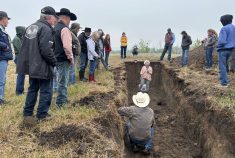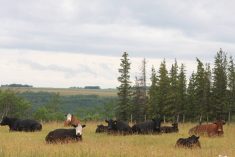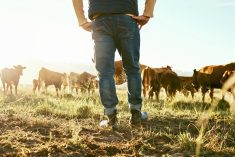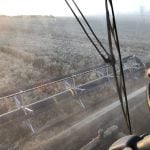I recently chatted with a colleague who has been proofing and copy-editing farm magazines, including this one, for several years. We discussed how things have changed in the industry since the ’80s — mainly the roles of women in farming and ranching, and the related professions. I think women have always been vital to this industry but were less visible in the past. That has changed quite a bit, and I think we’re better for it. Sometimes I wonder what it will be like for women half my age as they hit the workforce.
While we can always find some common experiences, every generation faces different obstacles and finds different opportunities (and often the opportunities and growth are closely related to the obstacles). Ron Clarke’s Vet Advice column in our January issue is a perfect example of this. He writes about the invention of barbed wire, and how it ended open-range grazing. It’s interesting to read a little bit about who adopted it, who didn’t, and where controversy erupted. Once it was available at a price point ranchers could afford, it was the answer to problems such as keeping cattle out of hay stocks, protecting the neighbours’ crops and managing grazing without several herders.
More than 100 years later, barbed wire remains the infrastructure that enables modern ranching management. It’s an everyday tool for people like Jim and Barb Bauer, also featured in this issue. Electric fence has sure been useful for those who want more flexibility in managing grazing. Whether virtual fencing takes off in Canada remains to be seen, but I’m sure there will be more fencing/cattle containment innovations in our future.
Read Also

The Canadian Cattle Association’s international advocacy efforts
Global ag policies affect Canadian food policy, so the Canadian Cattle Association participates in international and domestic forums
DNA testing is another technology that may not be widespread yet, but holds promise, at least for some segments of the beef industry. Other livestock sectors have been testing DNA for years, but beef producers haven’t adopted this technology the same way, due, at least in part, to the way the industry is structured. But there are likely opportunities there for seed stock producers, especially when combined with phenotyping and record-keeping. For those interested in collecting DNA during calving, but not sure where to start, we’ve got some practical considerations and tips in this issue.
Calving has also changed quite a bit in the last 20 or so years. BSE left its mark on how farmers and ranchers manage calving, too, and one of the results is easier-calving herds, with far fewer C-sections. The knowledge and advice around colostrum have changed, too — for example, we now know that the calf’s ability to absorb antibodies through its gut starts dropping after six hours and closes completely at 24 hours. Tubing warm colostrum is also a great way to help out a hypothermic calf, along with moderately warm air. We also now know that hanging a newborn calf upside down does not help resuscitate it — in fact, it compresses the calf’s lungs and diaphragm, restricting its breathing. If you’re looking for cold-weather calving info, I’ve posted a few helpful articles from the Beef Cattle Research Council and others on the Calf Central section on our website.
Speaking of the Beef Cattle Research Council, Reynold Bergen’s latest Research on the Record column was particularly fascinating to me. I have a close friend who works in health care, and we’ve had a few nerdy conversations about people’s microbiomes over the years. It’s something many human health care providers are watching, as there seems to be a link to the immune system. On the cattle side, two researchers reviewed several studies on microbiome development in livestock, humans and lab animals, looking for common ground. Interestingly, it looks like microbiomes in calves and other mammals first develop in utero — which, as Bergen writes, is another good reason for a robust winter-feeding program. For now, there’s not a lot of practical advice on fostering healthy microbiomes, beyond sticking to what we already know to be good practice. I mean, how do you manage a seemingly infinite number and variety of tiny little critters that you can’t even see, and still know very little about? The mysterious nature of those microbial worlds is a big part of the intrigue.
While adversity is not exactly a pleasant experience, it often triggers change. Labour for mammals is always risky business, so anything farmers and ranchers can do to deliver healthier calves adds to the bottom line and improves animal welfare. Combine a real need with a drive to create or learn something new, and you sometimes get significant innovations. Barbed wire fences addressed a need to manage livestock in vast ranges where other types of fencing were expensive, unavailable or impractical.
We face different challenges today than our grandparents and great-grandparents. But there are always people looking for the opportunity hidden within the challenge. It might be a big leap, or it might be a bunch of incremental changes that add up to something big. Whatever your situation this year, I wish you all the best in finding ways to answer the challenges before you.
















